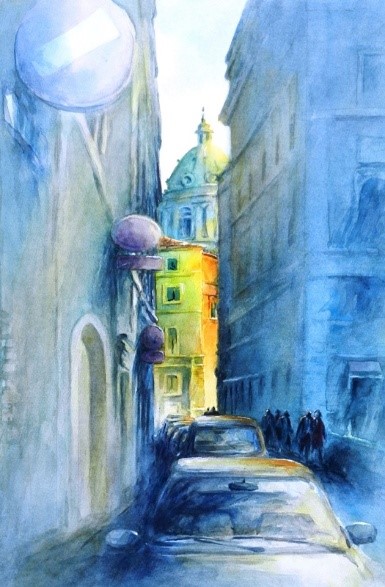Interested in an Original Painting?
Contact Virgil to inquire.
Interested in fine art prints and
more? Shop Fine Art America

“Rome Wasn’t Built in a Day”, Watercolor, 15” X 22”
![]() 1 June 2025
1 June 2025
Why Connection Matters
Connection is the invisible thread that binds artist, subject, and viewer. In watercolor, where spontaneity meets sensitivity, connection is not just emotional—it’s structural. It shapes how we see, feel, and translate the world onto paper.
What We Connect To
• The Subject: Whether it’s a landscape, a figure, or a fleeting moment, connection invites us to look deeper—beyond form into feeling.
• The Process: Watercolor rewards presence. Connection to the act of painting—its rhythm, flow, and unpredictability—grounds us in the now.
• The Viewer: Through mood, gesture, and atmosphere, we offer others a way in. Connection becomes a bridge between our inner world and theirs.
• A loose brushstroke that captures a breeze.
• A color choice that echoes memory.
• A composition that invites pause or longing.
Exercises to Explore Connection
1. Memory Mapping: Paint a place from memory. Focus on mood, not accuracy.
2. Silent Subject Study: Spend 5 minutes observing your subject without sketching. Then paint from feeling.
3. Soundtrack Session: Paint while listening to music that evokes a specific emotion. Let the sound guide your choices.
• What part of this subject resonates with me emotionally?
• How does my mood influence my brushwork today?
• What do I want the viewer to feel—and why?
Connection Part 2: Stories That Connect Using Watercolor
Today’s Blog is the second in our interrelated 3-part series on mood, connection and the power of painting the same or similar subjects differently. It is often said that story telling may be the strongest way to paint. And that the strongest paintings offer viewers the opportunity to view and connect with a painting based on their own individual experiences. So, let’s look at connection!


Storytelling in paint resonates because it invites connection, linking viewers experiences, ideas and emotions to a painting. When an artist weaves a story into their work, they provide a thread for viewers to hold onto and remember—a way to navigate emotions, ideas, or feelings that might otherwise feel abstract or distant, if at all. It’s not just about what the artist is saying but also about how the viewer responds and interprets it, creating a dialogue rather than a monologue.
Encouraging viewers to reflect over a painting, based on their own experiences, is vital because it makes the artwork personal. It transforms a painting from simply being something you look at into something you feel, about which there is a lasting impression—a connection!.
Here are some ways that connection can take place in a painting:
• Encourage Narrative Thinking: It’s essential to begin by considering a story to tell through a painting at the outset. It could be inspired by a memory, a place, or even an abstract emotion. This story can guide everything thereafter.
• Consider Atmosphere and Mood: The transparency and fluidity of watercolors are perfect for evoking moods and sharing ideas and emotions. Soft washes for serene or nostalgic feelings, bold strokes for intensity, or layered glazes for depth and mystery are examples of conveying emotions in paint.
• Embrace Imperfection: Watercolor naturally has an unpredictable quality, which can make the process feel alive and organic. Embrace the unexpected—these “happy accidents” often add character and interest.
• Composition as a Conversation: Composition is key—it can guide the viewer’s eye, like leading them through pages of a story. Through placement, perspective, and negative space, composition can guide the eye and spark curiosity, or suggest resolution.
• Experiment with Color: Color is synonymous with emotion. Thoughtful selection of a palette or using unusual or unexpected color combinations can make a painting feel distinctly personal.
• Let It Be Open-ended: Importantly, a painting does not need to tell the entire story outright. Leaving parts ambiguous encourages viewers to connect with the painting through their own experiences and imagination—the best, most lasting connection of all!


Personal engagement and connection breathe life into art, making it timeless and universally relevant. Connection allows every individual to see a unique version of a painting, shaped by their individual emotions, memories, and feelings.
Connection may be the highest and most important goal for an artist.
Contact Virgil to inquire.
more? Shop Fine Art America

“You Must Go Left or Right” , Watercolor, 30” X 11”